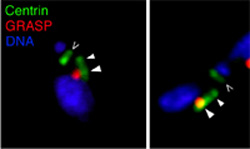Sleeping sickness parasite shows how cells divide their insides

Centrin (green), in a bi-lobed structure (filled arrowheads) associated with Golgi (red), shows growth of new Golgi and increasing separation from old Golgi accompanied by duplication and segregation of the bi-lobed structure. DNA is blue.
Researchers at Yale have brought to light a mechanism that regulates the way an internal organelle, the Golgi apparatus, duplicates as cells prepare to divide, according to a report in Science Express.
Graham Warren, professor of cell biology, and his colleagues at Yale study Trypanosoma brucei, the parasite that causes Sleeping Sickness. Like many parasites, it is exceptionally streamlined and has only one of each internal organelle, making it ideal for studying processes of more complex organisms that have many copies in each cell.
When thinking about how cells divide, doubling and separating DNA in chromosomes is often the focus. Equally important is the way a cell prepares its internal organelles for distribution. Warren studies the Golgi complex, a membrane compartment in the cytoplasm that delivers newly-made proteins to different membranes in the cell.
“Basal bodies in particular and centrosomes in general have been implicated in the biogenesis of a number of membrane-bound organelles,” said Warren. “It prompted us to study further their role in Golgi duplication.”
Warren’s group has identified a new cellular structure, distinct from the basal body, involved in the duplication of the Golgi apparatus and defined by a highly-conserved protein, Centrin2. This structure has two lobes — one at the old Golgi, the other where the new Golgi forms. Once a new Golgi has grown, the Centrin structure itself duplicates so that two complete structures, and associated Golgi, are ready to be allocated to daughter cells.
Significant recent advances in the molecular genetics of trypanosomes by Elisabetta Ullu and Christian Tschudi’s group at Yale, allowed direct manipulation of protein levels using the innate RNA interference (RNAi) system.The relationship between the growing Golgi, the Centrin proteins and other cellular organelles was shown in experiments using RNAi, and visualizing the process was possible with fluorescent protein tags. How this process relates to higher organisms is the focus of present research.
Media Contact
More Information:
http://www.yale.eduAll latest news from the category: Life Sciences and Chemistry
Articles and reports from the Life Sciences and chemistry area deal with applied and basic research into modern biology, chemistry and human medicine.
Valuable information can be found on a range of life sciences fields including bacteriology, biochemistry, bionics, bioinformatics, biophysics, biotechnology, genetics, geobotany, human biology, marine biology, microbiology, molecular biology, cellular biology, zoology, bioinorganic chemistry, microchemistry and environmental chemistry.
Newest articles

High-energy-density aqueous battery based on halogen multi-electron transfer
Traditional non-aqueous lithium-ion batteries have a high energy density, but their safety is compromised due to the flammable organic electrolytes they utilize. Aqueous batteries use water as the solvent for…

First-ever combined heart pump and pig kidney transplant
…gives new hope to patient with terminal illness. Surgeons at NYU Langone Health performed the first-ever combined mechanical heart pump and gene-edited pig kidney transplant surgery in a 54-year-old woman…

Biophysics: Testing how well biomarkers work
LMU researchers have developed a method to determine how reliably target proteins can be labeled using super-resolution fluorescence microscopy. Modern microscopy techniques make it possible to examine the inner workings…





















